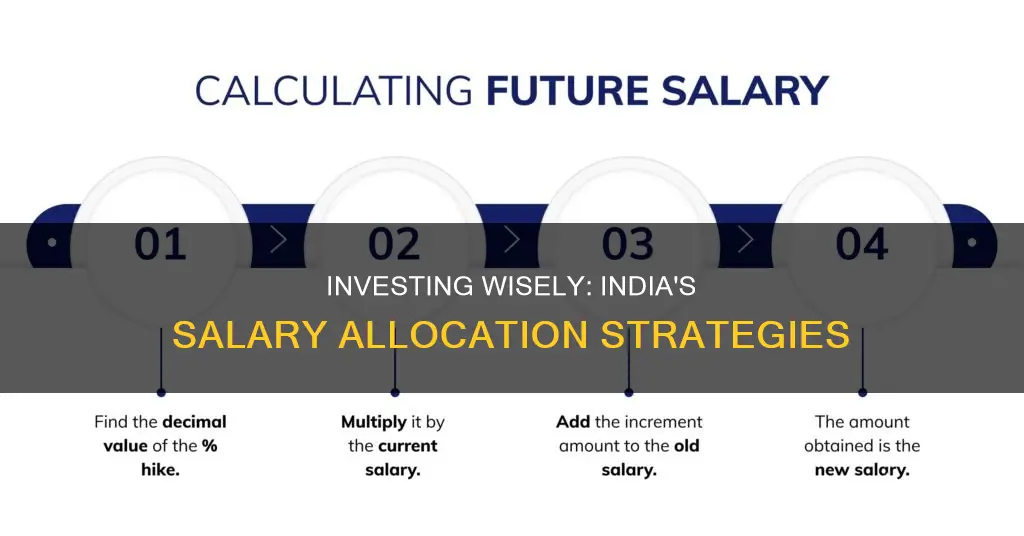
The percentage of salary that should be invested varies depending on individual circumstances, financial goals, and risk tolerance. While there is no one-size-fits-all answer, a commonly recommended guideline is to allocate 10-20% of your salary towards investments. This range allows for a balanced approach, providing potential growth while still leaving room for other financial obligations and savings. However, it's important to note that this percentage can be adjusted based on your specific situation and financial goals.
For example, if you have a salary of 15,000-30,000 INR, it is recommended to invest 20-30% of your salary in debt and equity if you are single and have no family responsibilities. On the other hand, if you are married with a child, you should focus on building an emergency fund and invest any remaining amount after expenses.
For salaries between 30,000 and 50,000 INR, it is suggested to invest around 10-15% in investments, in addition to insurance, provident funds, and other benefits provided by your company.
Those with a salary of 50,000 INR and above should aim to invest at least 20% of their income for the future. This includes long-term insurance, health insurance, disability insurance, emergency savings, and basic financial products like mutual funds, bonds, and fixed deposits.
It's important to carefully consider your financial goals and risk tolerance when deciding on the percentage of your salary to invest.
| Characteristics | Values |
|---|---|
| Recommended investment percentage | 10-20% |
| Recommended investment percentage for single people with no family responsibilities | 20-30% |
| Recommended investment percentage for people earning 30,000-50,000 INR | 10-15% |
| Recommended investment percentage for people earning 50,000 INR or more | 20% |
| Recommended investment percentage for people earning 2,50,000 INR or more | More than 20% |
| Recommended percentage for expenditure | 70% |
| Recommended percentage for emergency funds | 5% |
| Percentage of income to be spent on needs | 50% |
| Percentage of income to be spent on wants | 30% |
| Percentage of income to be spent on emergency corpus | 20% |
What You'll Learn
- The 50:30:20 rule: 50% on needs, 30% on wants, 20% for emergency funds
- Salary of 15,000-30,000 INR: insurance, health insurance, SIP, emergency fund
- Salary of 30,000-50,000 INR: term insurance, medical insurance, disability insurance, emergency funds, savings
- Salary of 50,000+ INR: long-term insurance, health insurance, disability insurance, emergency savings, basic financial products, real estate
- General rule: 10-20% of salary towards investments

The 50:30:20 rule: 50% on needs, 30% on wants, 20% for emergency funds
The 50:30:20 rule is a commonly recommended guideline for managing your money and is especially important for breadwinners to ensure a secure future. It involves dividing your after-tax income into three categories:
50% on Needs
The 'needs' category includes the bills you have to pay and things that are necessary for survival. This includes:
- Rent or mortgage payments
- Insurance and healthcare
- Groceries
- Utilities
- Minimum debt payments
- Transportation costs
- Student loan payments
If you're spending more than 50% of your income on needs, you may need to cut down on your expenses or downsize your lifestyle.
30% on Wants
The 'wants' category includes expenses that are not absolutely essential but that you spend money on to improve your quality of life. This includes:
- Gym memberships
- Vacations
- Movie or sporting event tickets
- Subscriptions to streaming services
- Unnecessary clothing or accessories
- The latest electronic gadgets
It is advisable to limit your spending on wants as much as possible.
20% for Emergency Funds
The remaining 20% of your income should be saved to build an emergency fund of at least three times your monthly salary. This money can be used for:
- An emergency fund
- Retirement contributions
- Mutual fund or investment account contributions
- A down payment on a home
- Debt repayments beyond the minimum payments
It's important to note that the 50:30:20 rule is a template and can be modified to fit your individual circumstances, financial goals, and risk tolerance. For example, if you live in an area with a high cost of living, you may need to adjust the percentages.
To adopt the 50:30:20 rule, start by tracking your expenses for a month or two to understand your spending habits. Then, set up automatic deposits and payments to simplify the process. It's also crucial to regularly review and adjust your investments to align with your changing circumstances and financial objectives.
Savings and Investments: Planning for Your Future
You may want to see also

Salary of 15,000-30,000 INR: insurance, health insurance, SIP, emergency fund
If you are earning between 15,000 and 30,000 INR per month, it is advisable to be cautious with your investments as this is the start of your financial career. It is recommended to have an emergency fund as backup. The amount you can invest will depend on your outgoings and whether you have any dependants.
If you are married with a child, you will likely have less money to invest each month. It is recommended that you take out a term insurance plan with coverage of 50 lakh or one crore, as well as health insurance to cover any medical emergencies. You should also consider investing in SIP Mutual Funds, which can be started with a minimum of 500 INR.
If you are single with no dependants, you can afford to be more aggressive with your investments, investing 20-30% of your salary in debt and equity. Make sure you avoid wasteful expenses and focus on building an emergency fund, saving a small amount each month.
In addition to the above, it is important to consider your financial goals when deciding how much to invest. Assess your target retirement age, life milestones, and any short-term financial goals. You should also consider your risk tolerance and how much risk you are comfortable with.
It is also worth noting that if your workplace provides a retirement savings plan, such as a 401(k), you should take full advantage of this, as many employers will match your contributions, effectively doubling your savings.
- Term Insurance Plan: Coverage of 50 lakh or one crore
- Health Insurance: To cover any medical emergencies
- SIP Mutual Funds: Can be started with a minimum of 500 INR
Diversifying Investments: Managing Financial Risk Strategically
You may want to see also

Salary of 30,000-50,000 INR: term insurance, medical insurance, disability insurance, emergency funds, savings
If you are earning a monthly salary of 30,000 to 50,000 INR, here is a guide on how to allocate your income towards term insurance, medical insurance, disability insurance, emergency funds, and savings.
Term Insurance
Term insurance provides financial protection for your loved ones in the event of your death. The popular rule of thumb for term insurance coverage is to aim for a sum that is 20 times your annual salary. This means that if you earn 360,000 to 600,000 INR annually, your term insurance coverage should be between 7.2 million and 12 million INR. However, this rule is just a starting point, and you should consider other factors such as the number of dependents, outstanding debts, living expenses, and future financial goals.
Medical Insurance
The ideal health insurance coverage varies depending on individual circumstances. As a general guideline, your medical insurance coverage should be at least 50% of your annual income. For someone earning 360,000 to 600,000 INR per year, this translates to an annual health insurance cover of 180,000 to 300,000 INR. Given the rising healthcare costs, insurance experts advise opting for a minimum cover of 500,000 INR to comfortably cover medical expenses.
Disability Insurance
Disability insurance provides financial protection if you are unable to work due to an accident or illness. The coverage amount for disability insurance depends on your income level and age. Assess your requirements and choose a plan that will enable you and your family to maintain your current lifestyle, even if your income disappears.
Emergency Funds
It is recommended to set aside 5% of your salary each month as emergency funds. For a monthly salary of 30,000 to 50,000 INR, this equates to an emergency fund contribution of 1,500 to 2,500 INR per month. Aim to save at least three to six months' worth of expenses, which can be used in case of unexpected events such as car repairs, medical emergencies, or job loss.
Savings
After allocating funds for the above-mentioned expenses, you can allocate the remaining amount towards savings and investments. A balanced approach suggests allocating 25% of your salary towards investments, which can include diverse options such as Systematic Investment Plans (SIP), Gold ETFs, Fixed Deposits, and Mutual Funds.
In summary, for a salary range of 30,000 to 50,000 INR, ensure adequate coverage for term insurance and medical insurance, set aside a portion for emergency funds, and allocate the remaining funds towards savings and investments to secure your financial future.
Smart Small Investments: A Guide for Indians
You may want to see also

Salary of 50,000+ INR: long-term insurance, health insurance, disability insurance, emergency savings, basic financial products, real estate
If you are earning a salary of 50,000+ INR, it is important to allocate your money across various financial instruments to ensure safety and growth of your portfolio. Here is a detailed guide on how to invest your money:
Long-term Insurance
Long-term insurance, such as life insurance, is crucial to provide financial security for your family in case something happens to you. Tarun Mathur, Chief Business Officer of General Insurance at Policybazaar.com, recommends that the coverage for a life insurance policy should be 12 to 15 times your annual income. For example, if you earn 50,000 INR per month, you should opt for a coverage of at least 60 lakhs to 75 lakhs INR. The premium for such a policy will be approximately 2.5% of your salary.
Health Insurance
Health insurance is another essential investment to protect yourself from the financial burden of medical emergencies. Leading financial experts recommend allocating about 2% to 5% of your monthly income towards health insurance coverage. For a salary of 50,000 INR per month, this translates to a health insurance premium of around 1000 to 2500 INR per month. When choosing a health insurance plan, consider factors such as age, pre-existing conditions, medical history, and family medical history.
Disability Insurance
Disability insurance provides income protection if you are unable to work due to a disability. While the specific rules and coverage vary, it is important to have adequate coverage to maintain your standard of living. Most group disability insurance policies will cover up to 60% of your income, while individual policies can provide up to 90% coverage.
Emergency Savings
Building an emergency fund is crucial to prepare for unexpected expenses such as job loss, medical emergencies, or other financial setbacks. A good rule of thumb is to save 3 to 6 months' worth of essential expenses. For someone earning 50,000 INR per month, this would translate to saving at least 1,50,000 to 3,00,000 INR in an emergency fund.
Basic Financial Products
When investing in basic financial products, it is important to diversify your portfolio to manage risk. Here are some options to consider:
- Mutual Funds: These are professionally managed investment schemes that pool money from multiple investors and invest in stocks, bonds, and other securities. Mutual funds offer the benefit of diversification and are regulated by SEBI to protect investor interests.
- National Pension System (NPS): NPS is a voluntary retirement savings scheme that enables individuals to make systematic savings during their working life and plan for their retirement.
- Corporate Fixed Deposits: These are offered by companies and typically provide higher interest rates than bank fixed deposits.
- Capital Gain Bonds: These bonds offer tax exemptions on long-term capital gains if the amount is invested in these bonds. The interest rate offered is around 6% per annum.
Real Estate
Investing in real estate can be a lucrative option, but it requires significant capital and knowledge of the market. Here are some ways to invest in real estate:
- Traditional/Conventional Investment: This involves buying or leasing a property and renting it out to tenants. It requires a substantial initial investment and incurs maintenance and upkeep costs.
- Renting Out a Portion of Your Existing Property: If you have extra space in your current home, you can generate income by renting it out to tenants.
- Fix-and-Flip: This strategy involves buying a property that needs maintenance, renovating it, and then selling it at a higher price. It requires knowledge of the real estate market and renovation costs.
- Investing via ETFs, Mutual Funds, and REITs: These investment vehicles allow you to invest in real estate indirectly by buying funds or trusts that are invested in real estate stocks, developers, or property management firms. They offer high liquidity and low costs but may not provide regular cash flow.
- Fractional Ownership: This involves multiple investors pooling their money to invest in a single real estate asset, typically a commercial property. It allows for diversification and lower investment costs.
Remember to consider your financial goals, risk appetite, and investment horizon when allocating your salary across these various options.
India's Superpower Status: American Investment Opportunities
You may want to see also

General rule: 10-20% of salary towards investments
When it comes to investing, there is no one-size-fits-all approach, but a good general rule of thumb is to allocate 10-20% of your salary towards investments. This allows for a balanced approach to managing your finances, providing potential growth while still allowing you to meet other financial obligations.
This percentage can be adjusted to suit your specific situation and financial goals. For example, if you are just starting out in your career and have lower earnings, you may want to invest a smaller percentage, whereas if you have aggressive financial goals or higher risk tolerance, you could consider investing a larger percentage.
It's important to consider your financial goals and risk tolerance when deciding how much to invest. If you are married with a child, for instance, your monthly expenses will be higher, leaving less room for investments. In this case, it's recommended to have an emergency fund in place and to invest any leftover funds in insurance plans and mutual funds.
On the other hand, if you are single with no family responsibilities, you may be able to invest a higher percentage of your salary, between 20-30%. It's important to avoid wasteful expenses and focus on creating an emergency fund, as well as investing in debt and equity.
As your income increases over time, you can proportionally increase the amount you invest to accelerate wealth creation. This approach ensures that you are consistently building towards your financial goals while also managing your short-term expenses and obligations.
By following these guidelines and tailoring them to your unique circumstances, you can make informed decisions about how much of your salary to invest and work towards achieving your long-term financial goals.
Invest in India: A Guide for US and Mauritian Investors
You may want to see also
Frequently asked questions
The recommended guideline is to allocate 10-20% of your salary towards investments. This range allows for a balanced approach, providing potential growth while still leaving room for other financial obligations and savings. However, this percentage can be adjusted based on your financial goals and risk tolerance.
The 50:30:20 rule is a commonly followed guideline, which suggests dividing your income into three categories: 50% for necessities, 30% for discretionary spending or 'wants', and 20% for savings and investments.
It is recommended to have an emergency fund that is at least three times your monthly salary. This fund should be easily accessible and provide high liquidity, so consider keeping it in liquid assets.







